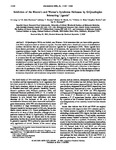Inhibition of the Bloom's and Werner's syndrome helicases by G-quadruplex interacting ligands.
| dc.contributor.author | Li, JL | en |
| dc.contributor.author | Harrison, RJ | en |
| dc.contributor.author | Reszka, AP | en |
| dc.contributor.author | Brosh, RM | en |
| dc.contributor.author | Bohr, VA | en |
| dc.contributor.author | Neidle, S | en |
| dc.contributor.author | Hickson, ID | en |
| dc.date.accessioned | 2017-11-27T19:53:43Z | |
| dc.date.available | 2017-11-27T19:53:43Z | |
| dc.date.issued | 2001-12-18 | en |
| dc.identifier.issn | 0006-2960 | en |
| dc.identifier.uri | http://hdl.handle.net/10026.1/10335 | |
| dc.description.abstract |
G-Quadruplex DNAs are folded, non-Watson-Crick structures that can form within guanine-rich DNA sequences such as telomeric repeats. Previous studies have identified a series of trisubstituted acridine derivatives that are potent and selective ligands for G-quadruplex DNA. These ligands have been shown previously to inhibit the activity of telomerase, the specialized reverse transcriptase that regulates telomere length. The RecQ family of DNA helicases, which includes the Bloom's (BLM) and Werner's (WRN) syndrome gene products, are apparently unique among cellular helicases in their ability to efficiently disrupt G-quadruplex DNA. This property may be relevant to telomere maintenance, since it is known that the sole budding yeast RecQ helicase, Sgs1p, is required for a telomerase-independent telomere lengthening pathway reminiscent of the "ALT" pathway in human cells. Here, we show that trisubstituted acridine ligands are potent inhibitors of the helicase activity of the BLM and WRN proteins on both G-quadruplex and B-form DNA substrates. Inhibition of helicase activity is associated with both a reduction in the level of binding of the helicase to G-quadruplex DNA and a reduction in the degree to which the G-quadruplex DNA can support DNA-dependent ATPase activity. We discuss these results in the context of the possible utility of trisubstituted acridines as antitumor agents for the disruption of both telomerase-dependent and telomerase-independent telomere maintenance. | en |
| dc.format.extent | 15194 - 15202 | en |
| dc.language | eng | en |
| dc.language.iso | eng | en |
| dc.subject | Acridines | en |
| dc.subject | Adenosine Triphosphatases | en |
| dc.subject | Antineoplastic Agents | en |
| dc.subject | Base Sequence | en |
| dc.subject | Bloom Syndrome | en |
| dc.subject | DNA | en |
| dc.subject | DNA Helicases | en |
| dc.subject | Humans | en |
| dc.subject | In Vitro Techniques | en |
| dc.subject | Ligands | en |
| dc.subject | Nucleic Acid Conformation | en |
| dc.subject | RecQ Helicases | en |
| dc.subject | Telomere | en |
| dc.subject | Werner Syndrome | en |
| dc.title | Inhibition of the Bloom's and Werner's syndrome helicases by G-quadruplex interacting ligands. | en |
| dc.type | Journal Article | |
| plymouth.author-url | https://www.ncbi.nlm.nih.gov/pubmed/11735402 | en |
| plymouth.issue | 50 | en |
| plymouth.volume | 40 | en |
| plymouth.publication-status | Published | en |
| plymouth.journal | Biochemistry | en |
| dc.identifier.doi | 10.1021/bi011067h | en |
| plymouth.organisational-group | /Plymouth | |
| plymouth.organisational-group | /Plymouth/REF 2021 Researchers by UoA | |
| plymouth.organisational-group | /Plymouth/REF 2021 Researchers by UoA/UoA01 Clinical Medicine | |
| plymouth.organisational-group | /Plymouth/REF 2021 Researchers by UoA/UoA01 Clinical Medicine/UoA01 Clinical Medicine | |
| dc.publisher.place | United States | en |
| dc.rights.embargoperiod | Not known | en |
| rioxxterms.versionofrecord | 10.1021/bi011067h | en |
| rioxxterms.licenseref.uri | http://www.rioxx.net/licenses/all-rights-reserved | en |
| rioxxterms.type | Journal Article/Review | en |


